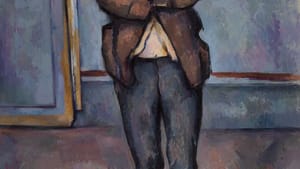Stay in the Loop
BSR publishes on a weekly schedule, with an email newsletter every Wednesday and Thursday morning. There’s no paywall, and subscribing is always free.
Spending an afternoon at the Barnes without leaving home

Like many of us who can’t afford a Renoir in the drawing room (or a drawing room to put it in), I subscribe to a range of art institutions across the city. In better days my walks include a 10-minute break at one or another of them. I flash my membership card and head straight to my favorite pieces for a little visit in the air conditioning. I am staying indoors now, and the Barnes Foundation has closed its building. But my computer can take me inside for a virtual visit that feels like I am right there, wandering rooms full of art.
Art to go
Barnes Takeout may be one of my favorite online things ever, better even than cat memes. Each weekday around lunchtime, the Barnes uploads a video to Youtube. A recent Takeout on Picasso’s The Peasants opens on a wall of art with a small inset of Gund Family Chief Curator Nancy Ireson in her apartment. “I wanted to share with you a picture that I really love because it reminds me of travel,” she says. We watch as Ireson clicks through on her own computer to focus on the painting. She tells us the story of Picasso’s travel by mule to a small town in Catalan and then zooms in on details of the painting that reflect his interest in the impressionists, and others that presage cubism. Ireson is warm and chatty. The video takes less than eight minutes.
When I talked to Martha Lucy, the Barnes’s Deputy Director for Research, Interpretation, and Education, she said that they wanted to do something fun that people could look forward to every day. “Our director [Thomas Collins] came up with this idea—you have an appointment with your Barnes takeout. You learn something, and when we do reopen, you’ll be able to come in with new knowledge about some of the things in our collection,” she said.
Virtual visits
If you prefer to wander through the Barnes on your own, the online collection lets you explore. Click on the link, and the screen shows photos of the works in the collection: a medieval painting, a Renoir nude, a Pennsylvania German blanket chest. Pick one—I clicked on Cézanne’s Peasant Standing with Arms Crossed. The image came up on the left, with a set of related images on the right. I thought these were suggestions—if you like this, you will also like these works—but Lucy set me straight. It’s the way Dr. Albert Barnes looked at art. “It may be the color that’s connecting them, it may be the use of line on the chest and the use of line in the painting. They’re not necessarily historically related, but they are visually related.”
Those relationships are important. If you click on the Ensemble link above the image, it takes you to a photo of the room in which the painting resides. This is Barnes’s vision. Lucy says the ensembles—the specific groupings of works—are like his own works of art. “He wanted you to think about how the Cézanne on that wall relates to the El Greco in the middle.”

Below the ensemble, a clickable photo of each piece in the frame will let you explore even further, but I wanted to learn more about Cézanne’s Paysan, so I followed the link to Information. Along with the technical data about the painting, I found the written description that appears in the mobile gallery app and a bibliography in case I wanted to really dig in. Not all the works have a description yet, but Lucy said they are working hard to get them all done.
The image is high resolution, as she gleefully explained: “You can just see things that you cannot see with the naked eye. I’m zooming in at the Paysan’s pants right now, just looking at the brushwork. It’s amazing!” If you are even more adventurous, you can sort the collection by color, light, angle, space (depth of field), or your own preference. I searched “Cézanne” and spent an afternoon following works of art through the virtual galleries, so be careful—it is addictive.
For the art nerds among us
If you want more than just a few lines of text, head for the Research Notes, the place where the Barnes shares its newest discoveries. “We’re still learning about where Barnes bought some of these things, and when,” Lucy told me. Curators, conservators, and researchers turn their discoveries into a deeper dive into the history, and even the politics of the time the work was created. If you wonder how Giorgio de Chirico’s Mysterious Swan relates to his memories of the seaside, this is for you.
If you want a really deep dive, the Barnes has moved its classes to live streaming online. Unlike the rest of the resources I’ve talked about, classes have a fee, but scholarships are available.
You can sign up for the Barnes on the usual social media platforms, but the content is all available on their website. Best of all, the Barnes online is open 24/7, wherever you are.
Sign up for our newsletter
All of the week's new articles, all in one place. Sign up for the free weekly BSR newsletters, and don't miss a conversation.

 Camille Bacon-Smith
Camille Bacon-Smith